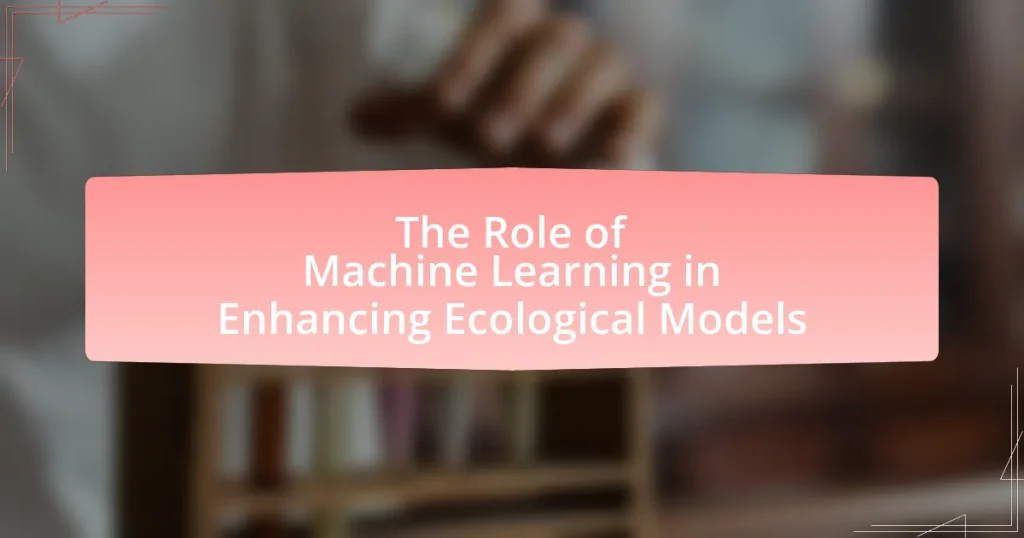The article focuses on the role of machine learning in enhancing ecological models, emphasizing its ability to improve predictive accuracy and analyze complex ecological data. It outlines how machine learning algorithms, such as random forests and neural networks, outperform traditional statistical methods in forecasting ecological outcomes, thereby aiding conservation and resource management. Key components of machine learning in this context include data collection, feature selection, model training, and evaluation, all of which contribute to more robust ecological simulations. The article also addresses challenges such as data quality, model interpretability, and ethical considerations, while highlighting future trends and practical steps for effective implementation in ecological research.

What is the Role of Machine Learning in Enhancing Ecological Models?
Machine learning plays a crucial role in enhancing ecological models by improving predictive accuracy and enabling the analysis of complex ecological data. It allows researchers to identify patterns and relationships within large datasets that traditional statistical methods may overlook. For instance, machine learning algorithms can process satellite imagery to monitor deforestation rates or analyze species distribution data to predict the impacts of climate change on biodiversity. Studies, such as those published in the journal “Ecological Applications,” demonstrate that machine learning techniques, like random forests and neural networks, significantly outperform conventional models in forecasting ecological outcomes, thereby providing more reliable tools for conservation and resource management.
How does Machine Learning integrate with Ecological Models?
Machine Learning integrates with Ecological Models by enhancing predictive accuracy and enabling the analysis of complex ecological data. Machine Learning algorithms can process large datasets, identify patterns, and make predictions about ecological phenomena, which traditional models may struggle to achieve. For instance, studies have shown that using Machine Learning techniques, such as random forests and neural networks, can significantly improve species distribution modeling by incorporating diverse environmental variables and historical data. This integration allows for more robust simulations of ecological dynamics, ultimately leading to better-informed conservation strategies and resource management.
What are the key components of Machine Learning in this context?
The key components of Machine Learning in the context of enhancing ecological models include data collection, feature selection, model selection, training, validation, and evaluation. Data collection involves gathering relevant ecological data, such as species distribution or environmental variables. Feature selection identifies the most significant variables that influence ecological outcomes, ensuring the model focuses on relevant information. Model selection involves choosing the appropriate algorithm, such as decision trees or neural networks, to analyze the data effectively. Training refers to the process of teaching the model using the collected data, while validation assesses the model’s performance on unseen data to prevent overfitting. Finally, evaluation measures the model’s accuracy and effectiveness in predicting ecological phenomena, often using metrics like precision and recall. These components work together to improve the predictive capabilities of ecological models, as evidenced by studies demonstrating enhanced forecasting accuracy when integrating Machine Learning techniques.
How do these components interact with ecological data?
Machine learning components interact with ecological data by analyzing complex patterns and relationships within the data to improve predictive modeling and decision-making. For instance, machine learning algorithms can process large datasets from ecological studies, such as species distribution, climate variables, and habitat characteristics, to identify trends and make accurate forecasts. Research has shown that machine learning techniques, like random forests and neural networks, significantly enhance the accuracy of ecological models, as evidenced by a study published in “Ecological Applications” by Elith et al. (2006), which demonstrated improved species distribution predictions using these methods.
What are the primary benefits of using Machine Learning in Ecological Models?
The primary benefits of using Machine Learning in Ecological Models include improved predictive accuracy, enhanced data analysis capabilities, and the ability to identify complex patterns in ecological data. Machine Learning algorithms can process large datasets more efficiently than traditional statistical methods, allowing researchers to uncover relationships and trends that may not be immediately apparent. For instance, studies have shown that Machine Learning techniques can significantly outperform conventional models in predicting species distributions and understanding ecosystem dynamics, as evidenced by research published in “Ecological Applications” by Elith et al. (2006), which demonstrated the effectiveness of these methods in ecological forecasting.
How does Machine Learning improve predictive accuracy in ecological studies?
Machine Learning improves predictive accuracy in ecological studies by enabling the analysis of complex datasets and identifying patterns that traditional statistical methods may overlook. This technology utilizes algorithms that can learn from data, allowing for more nuanced modeling of ecological phenomena. For instance, a study published in “Ecological Applications” by Cutler et al. (2007) demonstrated that machine learning techniques, such as random forests, significantly outperformed traditional regression models in predicting species distributions, achieving higher accuracy rates. This capability to process large volumes of data and adapt to new information enhances the reliability of ecological predictions, ultimately leading to better-informed conservation and management decisions.
What efficiencies does Machine Learning bring to ecological modeling processes?
Machine Learning enhances ecological modeling processes by improving predictive accuracy, increasing data processing efficiency, and enabling the analysis of complex ecological interactions. For instance, algorithms can analyze large datasets from remote sensing and field studies, identifying patterns and relationships that traditional methods may overlook. A study published in “Ecological Applications” by McCarthy et al. (2019) demonstrated that machine learning models outperformed conventional statistical approaches in predicting species distributions, achieving up to 20% higher accuracy. This efficiency allows ecologists to make more informed decisions regarding conservation and resource management, ultimately leading to better ecological outcomes.

What challenges exist in implementing Machine Learning in Ecological Models?
Implementing Machine Learning in ecological models faces several challenges, including data quality, model interpretability, and computational complexity. Data quality is critical, as ecological data can be sparse, noisy, or biased, which affects the model’s accuracy and reliability. For instance, a study by McCarthy et al. (2019) highlights that incomplete datasets can lead to misleading predictions in species distribution models. Model interpretability is another challenge; many machine learning algorithms operate as “black boxes,” making it difficult for ecologists to understand the underlying processes driving predictions. This lack of transparency can hinder the acceptance and application of these models in ecological research and policy-making. Lastly, computational complexity arises from the need for significant processing power and resources, especially when dealing with large datasets or complex models, which can limit accessibility for researchers with fewer resources.
What are the common obstacles faced by researchers?
Researchers commonly face obstacles such as limited funding, data accessibility issues, and time constraints. Limited funding restricts the scope of research projects, making it difficult to acquire necessary resources or hire skilled personnel. Data accessibility issues arise when researchers cannot obtain relevant datasets due to privacy concerns, proprietary restrictions, or lack of available data. Time constraints often hinder researchers from conducting thorough investigations or completing projects within deadlines, impacting the quality and depth of their work. These challenges are well-documented in studies highlighting the difficulties faced in various research fields, including ecological modeling.
How do data quality and availability impact Machine Learning applications?
Data quality and availability significantly impact Machine Learning applications by determining the accuracy and reliability of the models developed. High-quality data, characterized by completeness, consistency, and relevance, enables algorithms to learn effectively, leading to better predictions and insights. Conversely, poor data quality can result in biased models and erroneous conclusions. For instance, a study by Kelleher and Tierney (2018) in “Data Science for Economists” highlights that models trained on incomplete datasets often fail to generalize well, demonstrating the critical role of data integrity. Additionally, the availability of diverse datasets allows for more robust training, enhancing the model’s ability to adapt to various ecological scenarios. Thus, both data quality and availability are essential for the successful application of Machine Learning in ecological modeling.
What ethical considerations arise from using Machine Learning in ecology?
The ethical considerations arising from using Machine Learning in ecology include data privacy, bias in algorithms, and the potential for misuse of ecological data. Data privacy concerns stem from the collection and use of sensitive information about species and habitats, which could be exploited if not handled responsibly. Bias in algorithms can lead to skewed results, affecting conservation efforts and resource allocation; for instance, if training data underrepresents certain species, the model may fail to predict their needs accurately. Additionally, the potential for misuse of ecological data, such as using it for illegal poaching or habitat destruction, raises significant ethical dilemmas. These considerations highlight the need for ethical guidelines and frameworks to govern the application of Machine Learning in ecological research and practice.
How can researchers overcome these challenges?
Researchers can overcome challenges in enhancing ecological models with machine learning by integrating interdisciplinary collaboration, utilizing advanced computational tools, and adopting robust data management practices. Interdisciplinary collaboration allows researchers to combine expertise from ecology, computer science, and statistics, leading to more comprehensive model development. Advanced computational tools, such as high-performance computing and cloud-based platforms, facilitate the processing of large datasets, which is crucial for training machine learning algorithms effectively. Furthermore, robust data management practices, including data cleaning and standardization, ensure the quality and reliability of the input data, which is essential for accurate model predictions. These strategies collectively enhance the effectiveness of machine learning applications in ecological modeling.
What strategies can be employed to improve data quality?
To improve data quality, organizations can implement strategies such as data validation, regular audits, and the use of machine learning algorithms for anomaly detection. Data validation ensures that data entered into systems meets predefined criteria, reducing errors at the source. Regular audits help identify inconsistencies and inaccuracies in datasets, allowing for timely corrections. Machine learning algorithms can analyze large datasets to detect anomalies and patterns that may indicate data quality issues, thereby enhancing the overall integrity of the data. For instance, a study by Kelleher and Tierney (2018) highlights how machine learning techniques can significantly reduce errors in ecological data collection, demonstrating the effectiveness of these strategies in real-world applications.
How can interdisciplinary collaboration enhance Machine Learning applications?
Interdisciplinary collaboration can enhance Machine Learning applications by integrating diverse expertise, which leads to more robust models and innovative solutions. For instance, combining ecological science with data analytics allows for the development of predictive models that account for complex environmental variables. Research by H. J. H. van der Meer et al. in “Ecological Modelling” demonstrates that interdisciplinary teams improve model accuracy by incorporating ecological insights into algorithm design, resulting in better predictions of species distribution and ecosystem responses. This collaboration not only enriches the data interpretation but also fosters the creation of tailored Machine Learning algorithms that address specific ecological challenges.

What are the future trends of Machine Learning in Ecological Models?
Future trends of Machine Learning in ecological models include increased integration of deep learning techniques, enhanced predictive capabilities through ensemble methods, and the application of transfer learning to adapt models across different ecological contexts. These advancements are driven by the growing availability of large ecological datasets and the need for more accurate predictions of ecological dynamics. For instance, deep learning has shown significant promise in image recognition for species identification, while ensemble methods improve model robustness by combining predictions from multiple algorithms. Additionally, transfer learning allows researchers to leverage existing models trained on one ecological system to inform predictions in another, thereby accelerating research and conservation efforts.
How is technology evolving to support ecological modeling?
Technology is evolving to support ecological modeling primarily through advancements in machine learning and data analytics. Machine learning algorithms enhance the predictive capabilities of ecological models by analyzing large datasets, identifying patterns, and making accurate forecasts about ecological phenomena. For instance, the integration of remote sensing technologies allows for real-time data collection on environmental variables, which machine learning models can then process to improve habitat modeling and species distribution predictions. Research by McCarthy et al. (2019) in “Ecological Modelling” demonstrates that machine learning techniques can significantly outperform traditional statistical methods in predicting species responses to climate change, showcasing the effectiveness of these technological advancements in ecological modeling.
What role do advancements in computational power play?
Advancements in computational power significantly enhance the capabilities of machine learning algorithms used in ecological models. Increased computational power allows for the processing of vast datasets, enabling more complex simulations and analyses that were previously infeasible. For instance, high-performance computing resources facilitate the application of deep learning techniques to ecological data, improving predictive accuracy and model robustness. This is evidenced by studies such as those conducted by the National Center for Ecological Analysis and Synthesis, which demonstrate that enhanced computational resources lead to better understanding of ecological dynamics and improved conservation strategies.
How might new algorithms change the landscape of ecological modeling?
New algorithms can significantly transform ecological modeling by enhancing predictive accuracy and enabling the analysis of complex ecological interactions. For instance, machine learning techniques, such as random forests and neural networks, can process large datasets more efficiently than traditional statistical methods, allowing for the identification of non-linear relationships and interactions among ecological variables. Research has shown that machine learning models can outperform conventional models in predicting species distributions and ecosystem responses to environmental changes, as evidenced by studies like “Machine Learning for Ecological Modeling: A Review” published in the journal Ecological Modelling, which highlights the improved performance of these algorithms in various ecological applications.
What practical steps can researchers take to implement Machine Learning effectively?
Researchers can implement Machine Learning effectively by following a structured approach that includes data preparation, model selection, and validation. First, researchers should ensure high-quality data collection and preprocessing, as clean and relevant data is crucial for accurate model training. For instance, a study by Kelleher and Tierney (2018) emphasizes that data quality directly impacts model performance.
Next, selecting the appropriate Machine Learning algorithms based on the specific ecological problem is essential. Researchers should consider algorithms like decision trees or neural networks, depending on the complexity of the data and the desired outcomes. A comparative analysis by Hastie, Tibshirani, and Friedman (2009) illustrates that different algorithms yield varying results based on the dataset characteristics.
Finally, validating the model through techniques such as cross-validation ensures that the model generalizes well to unseen data. This step is supported by findings from the work of Bishop (2006), which highlights that robust validation techniques can significantly enhance model reliability. By adhering to these practical steps, researchers can effectively leverage Machine Learning to improve ecological models.
What best practices should be followed when integrating Machine Learning into ecological research?
Best practices for integrating Machine Learning into ecological research include ensuring data quality, selecting appropriate algorithms, and validating models rigorously. High-quality data is essential, as inaccuracies can lead to misleading results; for instance, a study by McCarthy et al. (2017) demonstrated that poor data quality significantly impacted model performance in ecological predictions. Choosing the right algorithms tailored to specific ecological questions enhances model effectiveness; research by Olden and Jackson (2008) highlighted that algorithm selection can influence the accuracy of species distribution models. Finally, rigorous validation through techniques such as cross-validation and independent testing is crucial to assess model reliability, as emphasized in the work of Fielding and Bell (1997), which established that robust validation methods improve the generalizability of ecological models.
How can researchers ensure the sustainability of their Machine Learning models?
Researchers can ensure the sustainability of their Machine Learning models by implementing continuous monitoring and updating practices. Continuous monitoring allows researchers to assess model performance over time, ensuring that the models remain relevant and effective as new data becomes available. Regular updates, based on this monitoring, help to adapt the models to changing conditions and improve their accuracy. For instance, a study published in the Journal of Machine Learning Research highlights that models that are regularly retrained with fresh data can maintain their predictive power and relevance, thereby supporting long-term ecological assessments.


